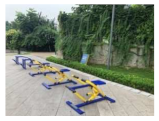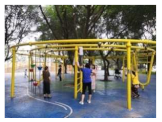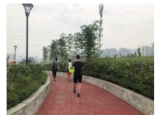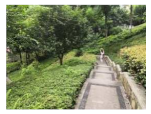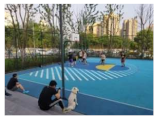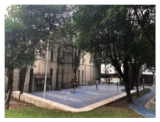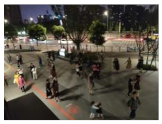Abstract
Urban green spaces provide multiple ecosystem services to improve human health and well-being. Cultural ecosystem services (CES) are recognized as the most important services for urban residents through the key of social interaction. Researchers commonly acknowledge the function of community sports parks to enhance social interaction. Nevertheless, existing studies generally do not pay enough attention to the influence mechanisms of community sports parks and social interaction, especially the different types of spaces in community sports parks, which could be due to the complex feature of social interaction. This paper selects three community sports parks in Chongqing as the case study, uses BBN to identify the influence mechanisms of three common types of spaces (fitness equipment space, path space, and sports court space) in community sports parks and social interaction, aiming to explore how community sports parks enhance social interaction. The results indicated that sports court space such as basketball court and badminton court enhanced social interaction best; however, the spaces farther away from the park entrances were generally less effective in enhancing interaction. All these three types of sports spaces showed the influence mechanism of “Spatial Factors-Activity Type-Social Interaction”, while differences existed in the specific spatial influencing factors. The findings highlight that based on the BBN obtained in this study, the threshold range of spatial factors could be adjusted to enhance the effect of community sports parks on social interaction.
1. Introduction
Urban green spaces provide multiple ecosystem services to improve human health and well-being [1]. “Ecosystem services” (ES) are the values and benefits that people derive from functioning ecosystems [2,3]. Vegetation in urban green spaces control climate, buffer noise, and filter air pollutants [4]. These ecosystem regulation services may prevent humans from diseases and promote healthy behavior through the provision of cultural ecosystem services (CES) [5,6]. CES are recognized as the most important services for urban residents which represent some of the most familiar and personal experiences of environment that people encounter in the cities [7,8,9]. Among CES, social interaction is regarded as a key to understanding the role of ecosystems in breaking down social barriers and bringing residents together [10].
Such interactions can alleviate social problems such as neighborhood conflicts and elderly isolation caused by rapid urbanization [11,12,13]. Particularly, the CES provided by the community parks that are an important place for the neighborhood to participate in activities together, meet others, and strengthen existing social ties, help enhancing social interaction and are currently receiving widespread attention [14,15]. With the increasing demand for physical exercise among residents [16], community sports parks, a new pattern of community parks, have begun to enter into the public view [16,17]. While many community green spaces include sports equipment, but they are mainly for residents’ daily leisure and relaxation with only a few basic fitness equipment inside. Unlike this type of green spaces, sport exercise is the main function of community sports park, using landscaping combined with various outdoor sports fields (including basketball court, badminton court, etc.,) in an independent land. In China, community sports park is a new type of community park, with an extended refining development.
As more and more residents tend to visit community sports parks for physical activities [17], opportunities for neighborhood contact and social interaction increase significantly, which can be achieved by the following two ways: First, physical activity mostly requires teamwork that offers good training opportunities for cultivating interpersonal communication skills [18,19]. It is a deeper and more intimate form of social interaction and can bring various socioeconomic and ethnic groups together, especially basketball and square dancing [20,21,22]. Second, physical activity have the function of upgrade self-efficacy and reduces social anxiety [18]. Previous research indicated that physical activity such as jogging and running were associated with enhancing self-efficacy [23], as well as individuals with higher self-efficacy have stronger ability to handle interpersonal relationship and their social anxiety is lower [18,24]. Meanwhile, runners seem to think of running in some way as a “social” activity [25]. Some research explore runners’ interactions with others in public places and highlight feelings of social support and inspiration generated through passing encounters with other park goers [26,27]. All these physical activities in community sports parks may make an essential contribution to enhancing social interaction, which are important to encouraging social interaction and leading a healthy lifestyle among residents.
Since their potential, a large number of natural experiments have shown that the spatial factors in community parks influence physical activity and social interactions. Moulay A. found that park space patterns with fewer visual obstacles and clear structure influenced duration of use, which in turn increased the potential for social interactions [28]. McCoemack et al. concluded that people were more likely to choose parks with public toilets, seats, and children’s playground for social interaction [29]. At the same time, the influence of non-spatial factors has also been suggested. For example, Staats and Hartighty showed that social relationship directly influenced the quality of personal interactions in public place [30]. Cox et al. suggested that young people were more likely to use parks for high-intensity social activity such as physical exercise, while older adults tended to engage in low-intensity social activity such as leisure and relaxation [31]. Duan explored the effect of age on social behavior in parks, concluding that men in parks were more active and inclined to engage in social behavior than women [32].
While these findings provide some insight into what factors influence social interaction in community sports parks (including spatial, activity, and individual differences factors), there is very limited evidence regarding the influence mechanism between them. Traditional mathematical and statistical methods such as conjoint analysis [33], structural equation modeling [14], and multiple regression modeling analysis [28], which are commonly used today, deal more with the direct and simple influence relationships. In fact, social interaction is a relatively complex process, its influence factors and the influence mechanism between these factors and social interaction may be multiple. A suitable method for model construction and meaningful interactions is a key point to clarify such complex relationships.
Graphical models, in particular, Bayesian belief network (BBN), are well-suited to deal with such complex problems because of their capability to combine the robust probabilistic methods with the lucidity of graphs that encode causal relationships between variables and [34], as such, offer a model structure for deriving uncertainty, unpredictability, imprecision, and complexity with the machine learning algorithm [35,36,37]. The BBN is also in line with the human ecological framework [38], which can deal with a large set of variables. It is a modeling tool that has already been successfully applied in the research field of environment and physical activity [39,40].
Additionally, different types of sports spaces in community sports park such as fitness equipment space, path space, and sports court space may have different influence mechanisms for social interaction. To our knowledge, not many studies addressed differences between various types of sports spaces in community sports park.
In this study, a BBN is used, therefore, is to better understand community sports park and how to enhance social interaction by considering multiple factors. The aims of this study are: (1) To clarify the influence mechanisms of enhancing social interaction with different types of sports spaces in community sports park; (2) to explore which is the most conductive type of space to enhance social interaction; (3) to find out the factors’ influence intensity of different types of sports spaces in community sports park. The results of this study will provide strategy or spatial optimization for community sports parks construction for enhancing their social interaction function in the future.
2. Social Interaction
Social interaction is defined as a process of reciprocal stimulation and interactivity between at least two people [41]. It can be measured through the amount of time people spend in the space, reflecting their engagement in public space and the intensity of interaction [42,43]. The space plays a role in bringing strangers from all walks of life together to become more familiar through congregate, meeting, and participating in activity together. Based on these key components of spatial social interactions, crowds congregate and engagement with the park are two important dimensions of social interactions measured in this study. Crowds congregate represents the opportunities for social contact; engagement with the park represents the intensity of interaction. Thus, variables for social interaction measurement are clear.
3. Methods
3.1. Sample Area
Chongqing is located in southwestern China and surrounded by mountains (Figure 1). Due to the topographical peculiarities, land use for community sports parks is limited. The Corner Land Project, turning “waste into treasure”, is trying to transform the scattered idle land around communities into community sports parks in different batches, solving the problems efficiently that are very popular among residents. Taking this project as a sample area may provide a good reference to understand the social interaction in community sports parks in other Chinese cities and cities in developing countries which are confronted with a similar urban context of limited land use. Finally, we selected Dashuijing, Huilongwan, and Danlong Community Sports Park (Table 1) as case study for three reasons.

Figure 1.
Map of Chongqing.

Table 1.
Basic overview of the three community sports parks.
First, we investigated twenty community sports parks in this project randomly in different batches and distributed them into three size categories: small, <0.5 ha; medium, 0.5–1 ha; and large, >1 ha, based on the classification of “Chongqing Community Sports and Cultural Park Construction Guidelines”. The selection aims to represent each size category.
Second, all of them are located in old city areas of different districts (Figure 2), and insufficient sports equipment was a major problem. For example, seriously damaged and single type equipment were common. Motivation of the project offered more spaces and convenience for residents, as well as achieving a good effect of promoting physical exercise and community interaction. In addition, these three parks all belong to the “First Batch of Parks” to be opened in 2019, which are typical cases for this study.

Figure 2.
Location and layout of the three community sports parks in main city area. Rea color refers to the study units with numbers.
Third, these parks construction style and inside function are similar, including fitness equipment, path, and sports court three common types of spaces that are well suited to our study needs. Based on field observation, we divided the parks into 35 spatial study units with these three different types of spaces to expand an in-depth study (Figure 2 and Table 2).

Table 2.
Different types of spaces’ corresponding unit numbers and photos.
3.2. Data Collection
Social interaction was measured by crowds congregate and engagement with the park, in which the basic data collection of crowds congregate was mainly by on-site survey and behavior mapping. Engagement with the park was measured by questionnaire survey, and 353 valid questionnaires were collected (124 from Dashuijing, 133 from Huilongwan and 96 from Danlong). Then, the specific data acquisition methods for both are as follows.
- (1)
- Crowds congregate
For each spatial study unit, the real distribution location of people was recorded through on-site survey, and the congregate times, total number of crowds congregate, and size of the congregate group were counted as the original data and calculated numerically by Formula (1). In order to ensure that the numerical quantification results of the trend of crowds congregate per unit area are more obvious and easier to compare and analyze, Formula (1) normalized the value of the level of crowds congregate, which can be expressed as follows.
where, Ai is the average total number of crowds congregate in the space; the same spatial study unit carries different group sizes of engagement, Bi is the size of the congregate group; Ti is the congregate times (min); N is the total number of people present in the space; S is the area of the spatial study unit (m2).
Considering that the total number of crowds congregate in the space may change during the social interaction, Ai is the average total number of crowds congregate in the space. So, the observation time is limited, as the time Ti in formula (1). According to the collection of basic data, the interaction congregate of people in the survey space would basically occur after more than 60 min for a large-scale membership change. Therefore, the observation time (Ti) was set in the range of 1–60 min. The calculation of Ai can be expressed as follows.
where, Aii is the total number of crowds in the space at the beginning of the interaction, Aio the total number of crowds in the space at the end of the interaction, each person is assumed to have appeared in the space only once.
- (2)
- Engagement with the park
Engagement with the park was measured by a questionnaire which consists of three parts, first part “The use of community sports parks”, second part “Engagement with the park” and third part “Personal situation” (Appendix A). The engagement quantitative results mainly came from the questionnaire’s second part that contained the following three points: (1) Subjective scoring the intensity of individual’s participation in the parks’ activity; (2) the intensity of willingness to use this space as the preferred activity space; (3) individual’s frequency of daily visits. This part of questionnaire used a scoring system, with scores from 1 to 7 indicating “low” to “high”, and the final engagement level was obtained by averaging the scores of the three questions.
However, engagement with the park would be obviously influenced by the individuals’ activity purposes. In order to ensure the accuracy of the average score results, before the questionnaire survey, we investigated the activity types in different spatial study units and summarized them (Table 3). The questionnaire survey was not random but covered all types of activity and took its proportion as reference. For example, in fitness equipment space, there were a lot of fitness equipment and chatting activities, hence we chose more people to complete the questionnaire, and chose only a few people who participated in relaxation and photo shoot activities to complete the questionnaire with not ignoring them.

Table 3.
Proportion of activities in three types of spaces in community sports parks.
The data collection was conducted on sunny days in April–May 2020, included two weekdays and two days, during the morning (7:30–11:30), afternoon (3:00–6:00), and evening (7:00–9:30). The selected spatial variables influencing community sports park’s interaction and their quantitative measures are shown in Table 4. For the non-spatial variables, activity type was measured by the presence or absence of sports activity, and leisure activity in the space was recorded on site. The specific classification and proportion of these two types of activity are shown in Table 3; individual difference included age, gender of the residents, and social relationship of their interaction partners. Social relationship reflects the range from alone, general neighborhood, familiar neighborhood, to family or friend relationship. All the variables used in further BBN are shown in Table 5.

Table 4.
Spatial variables that influence the community sports park’s interaction and their quantitative measurement methods.

Table 5.
All the variables used in further BBN.
3.3. Bayesian Belief Network
The BBN was used to analyze the relationship between spatial, activity, and individual difference and social interaction variables. The BBN consists of two parts: One is the directed acyclic graph (DAG), which represent the independence and causality relationships of the variables. Through machine learning algorithm, when the DAG shows a link of A → B (both A and B are variables), it represents the causality relationship. A is called a parent of B, B is a child of A (B could be the parent of another variable). Such as in this study, a link between physical activity and crowds congregate may be found, with physical activity is the parent of crowds congregate. The other is the conditional probability table (CPT), which represents the dependence level of a child variable on its parent variable. For example, “CPT for A → B” means the probabilities for each level of crowds congregate (from very low to very high) depend on the availability of physical activity (yes or no). Thus, we used the machine learning algorithm to separately modeling BBNs for each type of sport spaces in the sample community sports parks. The entire process of BBN modeling was conducted in Netica [46], and included three steps.
- First step: Draft network
In order to improve the efficiency of machine search in the subsequent stages, the network of influence links between variables was initially constructed using a priori knowledge derived from empirical data, relevant studies or expert knowledge, it was the initialization of the DAG [47].
- Second step: Training/calibration network
This step was as following: (1) Divided the sample data into a training set and a test set which were not overlapping. (2) Used the machine learning algorithm model to randomly create or remove dependencies between any two variables to generate a complete sketch of network relationships as the candidate network. (3) Adjusted the CPT to optimize the joint conditional probabilities for training each candidate network with the expectation–maximization (EM) algorithm method in the training set. The EM algorithm updated initial parameter estimates by iteratively refitting the case file data to the final model till convergence and minimizes negative log likelihood [48]. Through this step, we obtained some relatively high-quality networks.
- Third step: Test network
Finally, these candidate networks were tested. The resulting candidate networks were randomly tested for accuracy on the test set, and the network with the highest accuracy was selected as the final influence mechanisms. Because in this study, we are trying to confirm which and how the factors influence social interaction in community sports parks. So, the social interaction variable should be treat as criteria. The error rates of the crowds congregate variable and engagement with the park variable were calculated to achieve a probabilistic predictive evaluation of the network’s accuracy and precision. The calculation method is logarithmic loss, whose value is determined solely by the probability of the actual occurrence of the outcome [49], and the closer the value is to zero, the better the accuracy performance of the network is represented [50]. The final three types of sport spaces’ BBNs which were selected achieved accuracy rates of 74% crowds congregate and 76% engagement with the park in fitness equipment space, 56.25% and 75% accuracy in path space, 78% and 69% accuracy in sports court space.
We obtained the BBNs for fitness equipment space, path space, and sports court space, which represented the influence mechanisms to enhance social interaction in community sports parks. The CPT belongs to BBNs that predicted and analyzed the different level of crowds congregate and engagement with the park (as child variables) depended on its parent variables. At last, the BBNs model evaluation was necessary, it was possible to identify the most influential factors and the causal relationships of importance [50]. We applied the mutual information (entropy reduction) function in Netica for sensitivity analysis to evaluate the variables with greater influence on the target variables “crowds congregate” and “engagement with the park” [34]. Mutual information is symmetric between the two variables and is a predictor of the extent to which a finding of one variable (findings or explanatory variable) is expected to alter the beliefs (measured as entropy reduction) of another variable (query variable) [50,51,52]. The Netica software calculated the entropy reduction of other variables in the network, expressed as the query variables or as a percentage of the total entropy of the variables.
4. Analyses and Results
4.1. Social Interaction Features Analysis of the Community Sports Parks
The descriptive statistics of each node variable are shown in the network of Figure 3, Figure 4 and Figure 5, at the bottom number of each node box are indicated the means and standard deviations. The social interaction features of the three type spaces were analyzed in terms of the level of crowds congregate and engagement with the park, in which the level of crowds congregate was ranked as “sports court space (0.550) > path space (0.503) > fitness equipment space (0.426)”, and the level of engagement with the park was ranked as “ sports court space (4.69) > fitness equipment space (4.42) > path space (4.27)”. It could be concluded that the sports court space in community sports park was most conducive to promoting social interaction.

Figure 3.
BBN modeling of fitness equipment space.
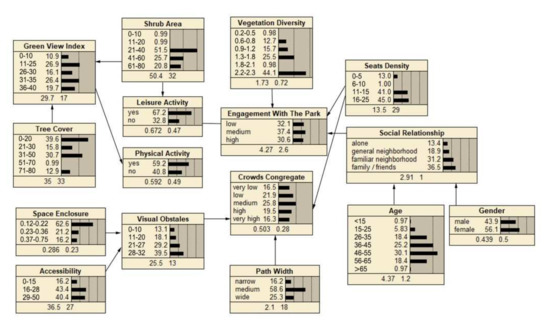
Figure 4.
BBN modeling of path space.
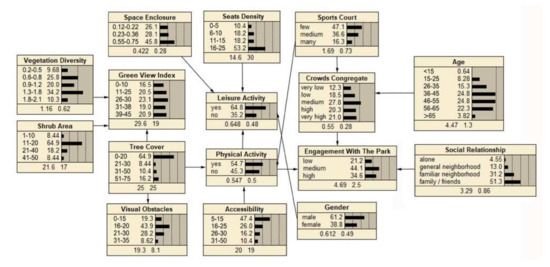
Figure 5.
BBN modeling of sports court space.
At the same time, analysis of the location of the spatial units showed that the crowds tended to congregate and interact near the park entrances, for example, the fitness equipment spaces with better congregate level were the unit of NO.1, NO.2, NO.24, and NO.26; the path spaces were the unit of NO.6, NO.7, NO.20, NO.22, and NO.32; the sports court spaces were the unit of NO.3, NO.4, NO.5, NO.17, NO.19, and NO.20, which were relatively close to the entrances rather than the inside of the park.
4.2. The BBNs of Community Sports Parks Enhancing Social Interaction
4.2.1. Fitness Equipment Space
The BBN of fitness equipment space to enhance social interaction is shown in Figure 3. In general, the results showed that the relationship between spatial factors and social interaction was mediated by the type of activity, with physical activity being the moderating variable for the level of crowds congregate and leisure activity for the level of engagement with the park.
Among the spatial factors, green view index, accessibility, visual obstacle and fitness equipment were all indirectly associated with the crowds congregate, which was mediated by the physical activity. Seats density was indirectly associated with engagement with the park, which was mediated by the leisure activity. Simultaneously, engagement with the park was indirectly influenced by children’s play equipment.
Another important factor that influenced social interaction was the individual difference. Gender influenced crowds congregate; age and social relationship influenced engagement with the park.
4.2.2. Path Space
The BBN of path space to enhance social interaction was shown in Figure 4. In general, crowds congregate was mainly influenced by the spatial perception structural factors of visual obstacle, path width, and seats density.
However, the factors that influenced engagement with the park were relatively complex, which were moderated by both leisure activity as a mediating variable and the direct influence of vegetation diversity, seats density, and social relationship. As the unique moderating variable, leisure activity was also influenced by the shrub area.
4.2.3. Sports Court Space
The BBN of sports court space to enhance social interaction was shown in Figure 5. The relationship between spatial factors and engagement with the park was mediated by sports activity, and sports activity directly influenced leisure activity; at the same time, engagement with the park was directly influenced by the crowds congregate.
In terms of spatial factors, space enclosure, accessibility, tree cover, and sports court directly influenced physical activity, while seats density directly influenced leisure activity.
In terms of individual difference factors, crowds congregate was influenced by age, and engagement with the park was influenced by social relationship.
4.3. Conditional Probability of Factors on Social Interaction
Table 6 and Table 7 show the conditional probabilities between all social interaction levels and their corresponding direct influence factors in the three types of spaces, which explained the BBNs in detail. In Table 6, such as path space with level of narrow (<1.5 m) path width had a slightly higher probability (19.3%) of very high level of crowds congregate than the level of medium (1.6–2 m, 17.9%) and wide (2.1–3.5 m, 18.2%) path width. Sports court space with many sport courts (more than three courts) had a slightly higher probability (21.1%) of very high level of crowds congregate than the level of medium (two courts, 19.5%) and few (only one courts, 20.8%) sport courts.

Table 6.
Conditional probabilities between all levels of crowds congregate and its direct influence factors of the three types of spaces.

Table 7.
Conditional probabilities between all levels of engagement with the park and its direct influence factors of the three types of spaces.
In Table 7, fitness equipment space with many children’s play equipment (more than three) had a higher probability (37.2%) of high level of engagement with the park among individuals than without (31.4%) and some (one or two, 33.9%) children’s play equipment. However, there is one exception, 36.4% of the respondents had a medium level of engagement with the park when without children’s play equipment, the children’s play features might explain this finding because they could play games and interact with friends even through a leaf or a stone, sometimes, equipment for them were absolutely unnecessary. We barely explained conditional probabilities between spatial factors and social interaction, which claimed the differences in park design lead to various uses and consequently for residents’ social interaction. Thus, compared with the non-spatial factors, adjusting the spatial factors to enhance social interaction could be more implementable.
4.4. Sensitivity Analysis for Factors’ Influence Intensity on Social Interaction
Sensitivity analysis in Netica (Norsys Software, Verison 6.07) obtained the strength of the relationship between the influence variables on social interaction. In fitness equipment space, the main influences on crowds congregate were physical activity (1.23) and gender (0.955), the main influences on engagement with the park were social relationship (0.64) and children’s play equipment (0.45) (Figure 6). In path space, the main influences on crowds congregate were view obstacle (0.529) and path width (0.248), the main influence on engagement with the park was leisure activity (0.237) (Figure 7). In sports court space, engagement with the park (7.12) had the greatest influence on crowds congregate, then the influence of the social relationship (0.709) was found to be significant to crowds congregate, while engagement with the park was mainly influenced by age (2.47) and sports court (0.377) (Figure 8).

Figure 6.
Sensitivity analysis on variables “crowds congregate” and “engagement with the park” using the entropy reduction (mutual information) of fitness equipment space.

Figure 7.
Sensitivity analysis on variables “crowds congregate” and “engagement with the park” using the entropy reduction (mutual information) of path space.

Figure 8.
Sensitivity analysis on variables “crowds congregate” and “engagement with the park” using the entropy reduction (mutual information) of sports court space.
5. Discussion
5.1. The Sports Court Space Is Most Conducive to Enhance Social Interaction
In this study, three types of spaces in community sports parks were identified (fitness equipment space, path space, and sports court space), and their influence mechanisms with social interaction appeared to be different. Through the comparison, we found that sports court space enhanced social interaction best, which means that in the future spatial design of community sports parks, provision of basketball courts, badminton courts, and other sports courts should be given priority. Meanwhile, attention should be paid to the environmental quality design of spaces farther away from the community sports parks’ entrances to enhance the efficiency of space use.
5.2. The Influence Mechanisms to Enhance Social Interaction with Three Types of Sport Spaces in Community Sprots Parks Are Different
The current study found that the influence mechanisms of three types of spaces to enhance social interaction had common features. First, engagement with the park in different types of spaces all influenced by social relationship. Second, the seats were the most important feature for encouraging leisure activity such as chatting and relaxing. Third, social interactions in three types of spaces were influenced by the mediating variable of “activity”. Additionally, the influence mechanisms also had significant differences.
5.2.1. Fitness Equipment Space: Physical Activity Mediate Crowds Congregate, Leisure Activity Mediate Engagement with the Park
In fitness equipment space (Figure 9), physical activity mediated crowds congregate, and the spatial factors influenced physical activity with fitness equipment, accessibility, view obstacle, and green view index, consistent with the findings of an Australian study, which showed that outdoor fitness equipment was effective in encouraging social interaction [53]. Results from our survey suggest, the usage of fitness equipment was higher, closer to the park entrance, which supported previous research indicating the relationship between accessibility and park social interaction [30]. Obstructed views influence people’s perception of space safety, which in turn influenced the activity and social interactions [28]. Aram F et al. argued that crowds always tended to socialize in places with greenery [54].

Figure 9.
Influence mechanism of fitness equipment space to enhance social interaction.
Furthermore, leisure activity mediated engagement with the park, and the spatial factors influenced leisure activity including seats density. It could be indicated that seats supported the leisure activity such as chatting, which were more likely to enhance deep social interaction. Children’s play equipment had a direct influence on engagement with the park. Previous studies on both children and adolescents’ social interaction suggested that the provision of playground/outdoor fitness equipment might be a best way to encourage park visitation [55].
Another important factor that directly influenced social interaction was individual difference, social relationship, and age influenced engagement with the park, gender influenced crowds congregate. For the common reason that most of the people are accompanied by friends and family when visiting the park, highlighting the importance of social relation aspects of park use [33]. Previous study showed that adults were more frequently observed using outdoor fitness equipment, with very low numbers of older adults [56,57,58]. However, our study result was in contrast to these previous studies indicated that fitness equipment might appeal to a variety of old adults. That is no surprise that elderly using parks for fitness activity is a common phenomenon in China. As more and more youngers have a stressful life and do not have enough time for outdoor exercise, which means, underscoring the importance of the park is an attractive feature for this target group [58]. Furthermore, compared with men, women interact with each other in public space usually need a higher perceived safety [59,60], which could explain the association between gender and crowds congregate in this study.
5.2.2. Path Space: Leisure Activity Mediate Engagement with the Park, Spatial Factors Directly Influence Crowds Congregate
In path space (Figure 10), leisure activity mediated engagement with the park, and leisure activity was influenced by shrub area. At the same time, engagement with the park was directly influenced by vegetation diversity. Overall, the results showed that landscape and greening were the main influence factors of engagement with the park. On the one hand, individuals always tend to interact in spaces with rich landscape vegetation; on the other hand, shrubs can provide sense of refuge [61,62], which is a prerequisite key for promoting the perception of safety in individuals’ interaction.

Figure 10.
Influence mechanism of path space to enhance social interaction.
Crowds congregate was mainly influenced by view obstacle, path width, and seats density. Visually linked will increase a sense of safety for engagement and interaction [28], and a prope path width can also enhance active interaction; the factors of view obstacle and path width influenced crowds congregate interaction through psychological perception and physical distance aspects. In addition, parks with benches are more popular due to the opportunity to alternate between physical and leisure activity and to rest after physical activity [63], which invariably increases the opportunities for interaction among strangers.
5.2.3. Sports Court Space: Engagement with the Park Is Mediated by Physical Activity and Directly Influenced by Crowds Congregate
In sports court space (Figure 11), physical activity mediated engagement with the park, while physical activity was mainly influenced by sports court, accessibility, tree cover, and space enclosure. Previous evidence had shown that physical activity such as basketball, badminton, and square dancing had a positive impact on deep interaction [20,21,64], which was intrinsic to the influence of sports court on individuals’ park engagement. The spaces near park entrances were more preferred by users, and directly linked the relation between accessibility and physical activity. Adequate tree cover can also provide resting shade spaces, especially in hot summer, which is suitable with residents’ physical activity needs. Sports court without fences seemed to be more popular. It could attract more people and lead to a better engagement with the park activity.
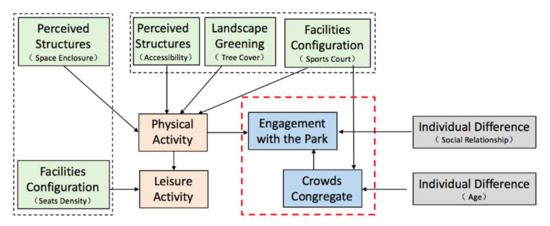
Figure 11.
Influence mechanism of sports court space to enhance social interaction.
Because activity features in this type of space are obvious, especially basketball and square dancing, the congregating number of people are usually above 10. These activities always require a higher and closer cooperation among individual members [19,20,21], and the participation is a deep interaction, leading to the results of crowds congregate influence individuals’ engagement with the park. Moreover, research survey showed that watch the game (13%) accounts for the most among leisure activity. More seats provided facilities for long-time game watching, therefore seats density is significantly influenced with leisure activity.
Compared with the other two types of spaces, activities in sports court space were mainly high-intensity ball sports, it would limit the participation of older adults, which was the intrinsic reason for the association between age and engagement with the park.
5.3. Factors’ Influence Intensity with Three Types of Sports Spaces in Community Sports Parks
In terms of the intensity of influence factors, non-spatial factors were the ones that strongly influenced all three types of spatial interactions. For example, physical activity (1.23) and gender (0.955) had the strongest influence on fitness equipment space interactions, age (2.47) also had a stronger influence on sports court space interactions. The reason may be that the entropy reduction function analysis in Netica was only able to identify the intensity of the direct influence variables on the target variables. Furthermore, the influence mechanism of “Spatial Factors-Activity Type-Social Interaction” could be constructed for all three types of spaces. Based on the BBNs obtained in this study, the threshold range of spatial factors could be adjusted to enhance the effect of community sports parks on social interaction.
5.4. Limitations
This study has a few limitations. The research procedure gave less insight regarding external factors of the sample study units which may influence park social interaction. First, most communities in China are closed, the other sports equipment inside the community was ignored, they may have an impact on the park use. Second, we did not consider the size of community sports parks. Previous research indicated that park size influenced individuals’ use and might provide different attributes of human social interaction and well-being [65], which is possible that there is, to some extent at least, a two-way relationship between park size and the individuals’ use of our case study. Future studies should explore this topic that shed more light on the existence and the direction of causality.
6. Conclusions
This study exposes the existing problems in planning and construction of community sports parks, which may be critical for the residents’ social health benefits and enhancing parks’ efficacy of interaction. This study compared the level of enhanced social interaction with the different types of sports spaces in community sports parks. Sports court space was found to be associated with a higher level of social interaction. The findings highlight the influence mechanisms of fitness equipment space, path space, and sports court space to enhance social interaction based on the obtained BBNs. The factors’ influence intensity in each type of space was calculated which directly influenced social interaction. Based on the influence mechanisms and factors’ influence intensity, the threshold range of spatial factors could be adjusted to a certain extent, providing theoretical references for the construction and spatial design to enhance the effect of community sports parks on social interaction in the future.
Author Contributions
Study conception and design, Y.S. and S.T.; methodology and software, Y.S.; data collection and analysis, Y.S., Q.H. and J.S.; writing—original draft preparation, Y.S.; writing—review and editing, Y.S., Q.H., S.T. and J.S. All authors have read and agreed to the published version of the manuscript.
Funding
This research was funded by the Graduate Student Research Innovation Project of Chongqing, China (NO: CYB20034).
Institutional Review Board Statement
Not applicable.
Informed Consent Statement
Informed consent was obtained from all subjects involved in the study.
Data Availability Statement
Not applicable.
Conflicts of Interest
The authors declare no conflict of interest.
Appendix A. The Survey Questionnaire
Hello! I am a graduate student of the School of Architecture and Urban Planning of Chongqing University. In order to enable our community sports park construction to meet your life needs to the utmost extent, and to enhance community-neighborhood communication, I would like to ask you some questions, please answer according to the actual situation. The survey results are for academic research use only, and there is no right or wrong answer. We assure not to disclose your personal information to the outside world. Therefore, please do not have any worries when filling in, and just answer according to your own real feelings. The whole process takes about 5 min, thank you for your cooperation! Please tick “√” under the option that suits your personal situation.
Appendix A.1. The use of Community Sports Parks
Appendix A.1.1. The Name of the Park You Are Currently in
□ Dashuijing Community Sports Park □ Huilongwan Community Sports Park □ Danlong Community Sports Park
Appendix A.1.2. The Number of the Space Unit You Are Currently in
Appendix A.1.3. The Type of Activity You Are Currently Participating in
□ Children’s equipment playing, □ Fitness equipment, □ Walking, □ Running,
□ Square dancing, □ Enjoying the scenery, □ Playing basketball, □ Playing badminton, □ Playing table tennis, □ Watching games, □ Walking the dog, □ Relaxation, □ Childcare, □ Photo shoot, □ Playing mobile, □ Family gathering, □ Chatting,
□ Hanging out, □ Neighborhood Meeting, □ Children playing, □ etc.
Appendix A.1.4. Do You Participate in This Type of Activity Alone (If Not, Please Fill in the Next Question)?
□ Yes □ No
Appendix A.1.5. The Type of Social Relationship between You and Your Partner
□ No partner □ General neighbors □ Familiar neighbors □ Family/Friends
Appendix A.2. Engagement with the Park
Appendix A.2.1. What Do You Think about the Extent to Which Type of Activity You Are Currently Participating in Has Promoted Social Interaction?
□ Deep low □ Very Low □ Low □ General □ High □ Very High □ Deep High
Appendix A.2.2. The Intensity of Your Willingness to Choose This Space Unit as Your Preferred Activity Space
□ Deep low □ Very Low □ Low □ General □ High □ Very High □ Deep High
Appendix A.2.3. The General Frequency of Your Daily Visit to This Park
□ Deep low □ Very Low □ Low □ General □ High □ Very High □ Deep High
Appendix A.3. Personal Situation
Appendix A.3.1. Your Gender
□ Male □ Female
Appendix A.3.2. Your Age
□ Under 14 □ 15–25 □ 26–35 □ 36–45 □ 46–55 □ 55–65 □ Over 65
Appendix A.3.3. Your Education Level
□ Elementary School □ Junior High School □ Senior High School/Technical School □ Junior Technical School □ Senior Technical School □ College □ Undergraduate □ Postgraduate
Appendix A.3.4. Your Occupation
- □
- Heads of state agencies, party organizations, enterprise networks, and public institutions
- □
- Professional skill worker
- □
- Clerks and related personnel
- □
- Commercial and service industry personnel
- □
- student
- □
- Skilled workers
- □
- Unprofessional workers
- □
- Self-employed
- □
- Temporary worker
- □
- other
Appendix A.3.5. Your Financial Income
- □
- Below 1000 yuan □ 1000–3000 yuan □ 3000–5000 yuan
- □
- 5000–10,000 yuan □ 10,000 yuan or more
Thank you again for your cooperation and wish you a happy life!
Appendix A is an optional section that can contain details and supplemental to the main text—this survey questionnaire would disrupt the flow of the main text but nonetheless remain crucial to understanding and reproducing the research shown, that would make the process of our survey for engagement with the park more easy and clear to understand.
References
- Fe, A.; Nka, B. Urban green spaces for the social interaction, health and well-being of older people—An integrated view of urban ecosystem services and socio-environmental justice-ScienceDirect. Environ. Sci. Policy 2020, 109, 36–44. [Google Scholar]
- Costanza, R.; d’Arge, R.; de Groot, R.; Farber, S.; Grasso, M.; Hannon, B.; Limburg, K.; Naeem, S.; O’Neil, R.V.; Paruelo, J.; et al. The value of the world’s ecosystem services and natural capital. Nature 1997, 387, 253–260. [Google Scholar] [CrossRef]
- Millennium Ecosystem Assessment (MEA). Ecosystems and Human Well-Being; Island Press: Washington, DC, USA, 2005. [Google Scholar]
- Costanza, R.; de Groot, R.D.; Braat, L.; Kubiszewski, I.; Fioramonti, L.; Sutton, P.; Farber, S.; Grasso, M. Twenty years of ecosystem services: How far have we come and how far do we still need to go? Ecosyst. Serv. 2017, 28, 1–16. [Google Scholar] [CrossRef]
- Kabisch, N.; van den Bosch, M.; Lafortezza, R. The health benefits of nature-based solutions to urbanization challenges for children and the elderly—A systematic review. Environ. Res. 2017, 159, 362–373. [Google Scholar] [CrossRef]
- Markevych, I.; Schoierer, J.; Hartig, T.; Chudnovsky, A.; Hystad, P.; Dzhambov, A.M.; de Vries, S.; Triguero-Mas, M.; Brauer, M.; Nieuwenhuijsen, M.J.; et al. Exploring pathways linking greenspace to health: Theoretical and methodological guidance. Environ. Res. 2017, 158, 301–317. [Google Scholar] [CrossRef]
- Larson, L.R.; Keith, S.J.; Fernandez, M.; Hallo, J.C.; Shafer, C.S.; Jennings, V. Ecosystem services and urban greenways: What’s the public’s perspective? Ecosyst. Serv. 2016, 22, 111–116. [Google Scholar] [CrossRef]
- Dickinson, D.C.; Hobbs, R.J. Cultural ecosystem services: Characteristics, challenges and lessons for urban green space research. Ecosyst. Serv. 2017, 25, 179–194. [Google Scholar] [CrossRef]
- Andersson, E.; Tengö, M.; McPhearson, T.; Kremer, P. Cultural ecosystem services as a gateway for improving urban sustainability. Ecosyst. Serv. 2015, 12, 165–168. [Google Scholar] [CrossRef]
- Petit-Boix, A.; Apul, D. From Cascade to Bottom-Up Ecosystem Services Model: How Does Social Cohesion Emerge from Urban Agriculture? Sustainability 2018, 10, 998. [Google Scholar] [CrossRef] [Green Version]
- Nicholson, N.R. A Review of Social Isolation: An Important but Underassessed Condition in Older Adults. J. Prim. Prev. 2012, 33, 137–152. [Google Scholar] [CrossRef]
- Han, B.; Cohen, D.; Mckenzie, T.L. Quantifying the contribution of neighborhood parks to physical activity. Prev. Med. 2013, 57, 483–487. [Google Scholar] [CrossRef] [PubMed] [Green Version]
- Bonsang, E.; Van Soest, A. Satisfaction with social contacts of older Europeans. Social Indic. Res. 2012, 105, 273–292. [Google Scholar] [CrossRef] [PubMed] [Green Version]
- Rasidi, M.H.; Jamirsah, N.; Said, I. Urban Green Space Design Affects Urban Residents’ Social Interaction. Procedia Soc. Behav. Sci. 2012, 68, 464–480. [Google Scholar] [CrossRef] [Green Version]
- Kaźmierczak, A. The contribution of local parks to neighbourhood social ties. Landsc. Urban Plan. 2013, 109, 31–44. [Google Scholar] [CrossRef]
- State Sport General Administration of China. 2015. Available online: https://www.sport.gov.cn/searchweb/news.jsp (accessed on 10 December 2021).
- Urban Planning and Natural Resources Department in Chongqing. 2021. Available online: http://ghzrzyj.cq.gov.cn/zwxx_186/mtgz/202101/t20210118_8779463.html (accessed on 10 December 2021).
- Gallagher, M.W.; Payne, L.A.; White, K.S.; Shear, K.M.; Woods, S.W.; Gorman, J.M.; Barlow, D.H. Mechanisms of change in cognitive behavioral therapy for panic disorder: The unique effects of self-efficacy and anxiety sensitivity. Behav. Res. Ther. 2013, 51, 767–777. [Google Scholar] [CrossRef] [Green Version]
- Baskin, M.L.; Dulin-Keita, A.; Thind, H.; Godsey, E. Social and Cultural Environment Factors Influencing Physical Activity among African-American Adolescents. J. Adolesc. Health 2015, 56, 536–542. [Google Scholar] [CrossRef]
- Woodhouse, D.; Conricode, D. In-ger-land, In-ger-land, In-ger-land! Exploring the impact of soccer on the sense of belonging of those seeking asylum in the UK. Int. Rev. Sociol. Sport 2017, 52, 940–954. [Google Scholar] [CrossRef] [Green Version]
- Stone, C. Utopian community football? Sport, hope and belongingness in the lives of refugees and asylum seekers. Leis. Stud. 2018, 37, 171–183. [Google Scholar] [CrossRef]
- Contiero, D. Dojo and traditional martial arts: A social community for physical activity and health prevention in later age. J. Sci. Med. Sport 2019, 22, S82. [Google Scholar] [CrossRef]
- Luszczynska, A.; Mazurkiewica, M.; Ziegelmann, J.P.; Schwarzer, R. Recovery self-efficacy and intention as predictors of running or jogging behavior: A cross-lagged panel analysis over a two-year period-ScienceDirect. Psychol. Sport Exerc. 2007, 8, 247–260. [Google Scholar] [CrossRef] [Green Version]
- Ren, Y.; Li, M. Influence of physical exercise on social anxiety of left-behind children in rural areas in China: The mediator and moderator role of perceived social support. J. Affect. Disord. 2020, 266, 223–229. [Google Scholar] [CrossRef] [PubMed]
- Hitchings, R.; Latham, A. How ‘social’ is recreational running? Findings from a qualitative study in London and implications for public health promotion. Health Place 2017, 46, 337–343. [Google Scholar] [CrossRef] [PubMed]
- Krenichyn, K. Women and physical activity in an urban park: Enrichment and support through an ethic of care. J. Environ. Psychol. 2004, 24, 117–130. [Google Scholar] [CrossRef]
- Krenichyn, K. ‘The only place to go and be in the city’: Women talk about exercise, being outdoors, and the meanings of a large urban park. Health Place 2006, 12, 631–643. [Google Scholar] [CrossRef]
- Moulay, A.; Ujang, N.; Said, I. Legibility of neighborhood parks as a predicator for enhanced social interaction towards social sustainability. Cities 2016, 61, 58–64. [Google Scholar] [CrossRef]
- McCormack, G.R.; Rock, M.; Toohey, A.M.; Hignell, D. Characteristics of urban parks associated with park use and physical activity: A review of qualitative research. Health Place 2010, 16, 712–726. [Google Scholar] [CrossRef]
- Staats, H.; Hartig, T. Alone or with a friend: A social context for psychological restoration and environmental preferences. J. Environ. Psychol. 2004, 24, 199–211. [Google Scholar] [CrossRef]
- Cox, D.T.; Hudson, H.L.; Shanahan, D.F.; Fuller, R.; Gaston, K.J. The rarity of direct experiences of nature in an urban population. Landsc. Urban Plan. 2017, 160, 79–84. [Google Scholar] [CrossRef] [Green Version]
- Duan, Y.; Wagner, P.; Zhang, R.; Wulff, H.; Brehm, W. Physical activity areas in urban parks and their use by the elderly from two cities in China and Germany. Landsc. Urban Plan. 2018, 178, 261–269. [Google Scholar] [CrossRef]
- Linde, V.H.; Ariane, G.; Jelle, V.C.; Veitch, J.; De Bourdeaudhuij, I.; Van Dyck, D.; Clarys, P.; Van De Weghe, N.; Deforche, B. Park characteristics preferred for adolescent park visitation and physical activity: A choice-based conjoint analysis using manipulated photographs. Landsc. Urban Plan. 2018, 178, 144–155. [Google Scholar]
- Dlamini, W.M. A Bayesian belief network analysis of factors influencing wildfire occurrence in Swaziland. Environ. Model. Softw. 2010, 25, 199–208. [Google Scholar] [CrossRef]
- Martin, T.G.; Kuhnert, P.M.; Mengersen, K.; Possingham, H. The power of expert opinion in ecological models using Bayesian methods: Impact of grazing on birds. Ecol. Appl. 2005, 15, 266–280. [Google Scholar] [CrossRef] [Green Version]
- McCann, R.K.; Marcot, B.G.; Ellis, R. Bayesian belief networks: Applications in ecology and natural resource management. Can. J. For. Res. 2006, 36, 3053–3062. [Google Scholar] [CrossRef]
- Tremblay, J.-P.; Hester, A.; Mcleod, J.; Huot, J. Choice and development of decision support tools for the sustainable management of deer-forest systems. For. Ecol. Manag. 2004, 191, 1–16. [Google Scholar] [CrossRef]
- Bronfenbrenner, U. The Ecology of Human Development: Experiments by Nature and Design; Harvard University Press: Cambridge, MA, USA, 1979. [Google Scholar]
- Kemperman, A.; Timmermans, H. Green spaces in the direct living environment and social contacts of the aging population. Landsc. Urban Plan. 2014, 129, 44–54. [Google Scholar] [CrossRef]
- Kemperman, A.D.A.M.; Timmermans, H.J.P. Children’s recreational physical activity. Leis. Sci. 2011, 33, 183–204. [Google Scholar] [CrossRef]
- Hari, R.; Kujala, M.V. Brain basis of human social interaction: From concepts to brain imaging. Physiol. Rev. 2009, 89, 453–479. [Google Scholar] [CrossRef] [Green Version]
- Carmona, M.; Tiesdell, S.; Heath, T.; Oc, T. Public Places—Urban Spaces: The Dimensions of Urban Design; Routledge: Oxfordshire, UK, 2010. [Google Scholar]
- Gehl, J. Life between Buildings: Using Public Spaces; The John Hopkins University Press: London, UK, 2011. [Google Scholar]
- Smardon, R.C.; Palmer, J.F.; Felleman, J.P. Foundations for Visual Project Analysis; McGraw Hill: New York, NY, USA, 1986. [Google Scholar]
- Han, K.T. The Effect of Nature and Physical Activity on Emotions and Attention while Engaging in Green Exercise. Urban For. Urban Green. 2017, 24, 5–13. [Google Scholar] [CrossRef]
- Norsys Software Corporation. Netica Verison 6.07. Available online: https://www.norsys.com/download.html (accessed on 10 December 2021).
- Cain, J. Planning Improvements in Natural Resources Management: Guidelines for Using Bayesian Belief Networks to Support the Planning and Management of Development Programmes in the Water Sector and Beyond; Centre for Ecology and Hydrology: Wallingford, UK, 2001. [Google Scholar]
- Lauritzen, S.L. The EM algorithm for graphical association models with missing data. Comput. Stat. Data Anal. 1995, 19, 191–201. [Google Scholar] [CrossRef]
- Kalácska, M.; Sánchez-Azofeifa, G.A.; Caelli, T.; Rivard, B.; Boerlage, B. Estimating leaf area index from satellite imagery using Bayesian belief networks. IEEE Trans. Geosci. Remote Sens. 2005, 43, 1866–1873. [Google Scholar] [CrossRef]
- Colwell, R.G.; Dawid, A.P.; Speigelhalter, D.J. Sequential model criticism in probabilistic expert systems. IEEE Trans. Pattern Anal. Mach. Intell. 1993, 15, 209–219. [Google Scholar] [CrossRef]
- Korb, K.B.; Nicholson, A.E. Bayesian Artificial Intelligence; CRC Press: London, UK, 2004. [Google Scholar]
- Pearl, J. Probabilistic Reasoning in Intelligent Systems: Networks of Plausible Inference; Morgan Kaufmann: San Mateo, CA, USA, 1998. [Google Scholar]
- Pollino, C.A.; Woodberry, O.; Nicholson, A.; Korb, K.; Hart, B.T. Parameterisation and evaluation of a Bayesian belief network for use in an ecological risk assessment. Environ. Model. Softw. 2007, 22, 1140–1152. [Google Scholar] [CrossRef]
- Furber, S.; Pomroy, H.; Grego, S.; Tavener-Smith, K. People’s experiences of using outdoor gym equipment in parks. Health Promot. J. Aust. 2014, 25, 211. [Google Scholar] [CrossRef] [PubMed] [Green Version]
- Aram, F.; Solgi, E.; Holden, G. The role of green spaces in increasing social interactions in neighborhoods with periodic markets. Habitat Int. 2019, 84, 24–32. [Google Scholar] [CrossRef]
- Cohen, D.A.; Marsh, T.; Williamson, S.; Golinelli, D.; McKenzie, T.L. Impact and cost-effectiveness of family Fitness Zones: A natural experiment in urban public parks. Health Place 2012, 18, 39–45. [Google Scholar] [CrossRef] [Green Version]
- Cranney, L.; Phongsavan, P.; Kariuki, M.; Stride, V.; Scott, A.; Hua, M. Impact of an outdoor gym on park users’ physical activity: A natural experiment. Health Place 2016, 37, 26–34. [Google Scholar] [CrossRef]
- Veitch, J.; Salmon, J.; Abbott, G.; Timpiero, A.; Sahlqvist, S. Understanding the impact of the installation of outdoor fitness equipment and a multi-sports court on park visitation and park-based physical activity: A natural experiment. Health Place 2021, 71, 102662. [Google Scholar] [CrossRef]
- Veitch, J.; Salmon, J.; Ball, K. Children’s perceptions of the use of public open spaces for active free-play. Child. Geogr. 2007, 5, 409–422. [Google Scholar] [CrossRef] [Green Version]
- Lloyd, K.; Burden, J.; Kieva, J. Young girls and urban parks: Planning for transition through adolescence. J. Park Recreat. Adm. 2008, 26, 21–38. [Google Scholar]
- Grahn, P.; Stigsdotter, U.K. Workplace greenery and perceived level of stress: Benefits of access to a green outdoor environment at the workplace. Landsc. Urban Plan. 2013, 110, 5–11. [Google Scholar]
- Stigsdotter, U.K.; Corazon, S.S.; Sidenius, U.; Refshauge, A.D.; Patrik, G. Forest design for mental health promotion-using perceived sensory dimensions to elicit restorative responses. Landsc. Urban Plan. 2017, 160, 1–15. [Google Scholar] [CrossRef]
- Van Hecke, L.; Loyen, A.; Verloigne, M.; van der Ploeg, H.P.; Lakerveld, J.; Brug, J.; De Bourdeaudhuij, I.; Ekelund, U.; Donnelly, A.; Hendriksen, I.; et al. Variation in population levels of physical activity in European children and adolescents according to cross-European studies: A systematic literature review within DEDIPAC. Int. J. Behav. Nutr. Phys. Act. 2016, 13, 70. [Google Scholar] [CrossRef] [PubMed] [Green Version]
- King, K.A.; Vidourek, R.A.; English, L.; Merianos, A.L. Vigorous physical activity among college students: Using the health belief model to assess involvement and social support. Arch. Exerc. Health Dis. 2013, 4, 267–279. [Google Scholar] [CrossRef]
- Ayala-Azcárraga, C.; Diaz, D.; Zambrano, L. Characteristics of urban parks and their relation to user well-being. Landsc. Urban Plan. 2019, 189, 27–35. [Google Scholar] [CrossRef]
Publisher’s Note: MDPI stays neutral with regard to jurisdictional claims in published maps and institutional affiliations. |
© 2022 by the authors. Licensee MDPI, Basel, Switzerland. This article is an open access article distributed under the terms and conditions of the Creative Commons Attribution (CC BY) license (https://creativecommons.org/licenses/by/4.0/).
